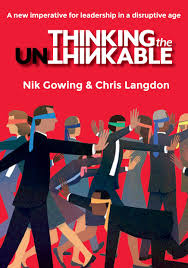Thinking the Unithinkable

To be honest, I’ve been involved with this project almost from its inception. I met Chris Langdon at a conference in 2015 and have been advising him and Nik Gowing both on the book and the larger project ever since. So, it should not come as a surprise that I loved this book, not as a polished, finished document, but as a work in progress designed to shock us all and goad us into action.
This is the rare book whose cover tells you a lot. Its background color is red to convey its warning and the image depicts well dressed men and women wandering around wearing blindfolds to reflect their (and our) confusion. Think the Unthinkable began as a modest research project commissioned to mark the fiftieth anniversary of Sir Winston Churchill’s death. It soon morphed from a research effort into the early stages of an effort to get today’s and tomorrow’s leaders to think about the unthinkable, unimaginable, and unpalatable (all words they use) sweeping the world today.
The authors started out interviewing C-Suite leaders in the public and private sector in their native UK, the U.S., and Singapore. Soon, they realized that they had to include not only the rest of the world but the next generation of leaders from the much-maligned millennial generation who had surprisingly intriguing ideas about what could or should come next.
You won’t be surprised by the list of unthinkables that actually grew as they were writing. Politics. Technology. Rate of change. Complacency and conformity.
Or by the list of solutions the suggest. Innovation. Experimentation. Learning from young people. Adapting to your environment.
You will be surprised by the degree to which senior leaders were willing to say how unprepared they and their organizations were to deal with the unthinkable—including many who did so on the record. These weren’t people who normally cry wolf; instead, they are the people who have made it to the top. And they are willing to say how unprepared they are for a VUCA (volatile, uncertain, complex, and ambiguous) world with wicked problems whose causes and consequences are so inextricably intertwined that they cannot be solved quickly, easily, or separately if you can solve them at all.
But this is not a book about doom and gloom. They also report on some success stories, including companies that have recovered from unthinkable disasters like Safaricom, rebuilt themselves like a leading phosphate producer or Singaporean bank, and the British army.
Much of the credit goes to a few characteristics. Many realize the need to welcome disruption and use it as an opportunity to try out new ideas. Many do so because they hire people from diverse backgrounds and give them lots of leeway. Many, in particular, have discovered the importance of learning from staff members from the millennial generation who have always lived in a world of constant change and for whom conformity makes no sense at all.
If you are expecting a polished book that will give you a neat and tidy roadmap, Think the Unthinkable is not for you. The book was intentionally written in a hurry so it could be published as soon as possible and could be updated on the fly—I know because I read a number of the preliminary drafts and had to do so in record time. Still, both the book and the community they are creating around www.thinkunthink.org are worth your time.
